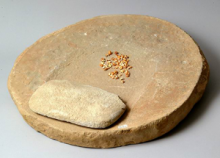Article
Also referenced as a meal stone by Hillerman, a metate is a slab of rock with either a concave or flat surface that is used for manually grinding grain, ochre, or other plant and mineral products. The mealing of grain, seeds, or sometimes even coffee on a metate is done using a mano, which is a smaller stone that is pressed back-and-forth horizontally or in a circular motion against the surface of the stone slab. The term metate comes from the word metatl, which is a term used in Mexico by indigenous peoples to describe these artifacts. Additionally, the term mano comes from the Spanish word for “hand.” Through both archaeological excavations and modern ethnography, it is known that metates have been in continuous use for thousands of years.
In North America, metates were already an important tool used by indigenous people prior to the introduction of corn from Mesoamerica. Metates first appear in the American Southwest during the Early Archaic Period (8,500 BP – 5,500 BP) and mark the transition from Paleoindian Period to the Archaic Period. Dubbed “site furniture” by former UNM professor of anthropology, Lewis Binford, these grinding implements were often left behind, due to their size and weight, in even the most transitory processing camps. Upon the introduction and spread of domesticated corn, the metates became larger and more trough-like, their deep basins allowing for the mass processing of maize. Metates became a common household tool, especially in Mexico and what is now the Southwestern U.S., where it was primarily the women's responsibility to grind corn into coarse meal for making tortillas, small unleavened pieces of bread, which are a staple food in the region. In modern archaeology, phytolith, pollen, and macro-botanical analysis can be conducted using the plant and mineral residue on metates to reconstruct prehistoric diets.
"Metate, mano, and corn kernels, circa 1000 CE, Chaco Culture National Historical Park" by US-NPS is licensed under Public Domain.
Manuscripts
References
Binford, Lewis R.
1980 Willow Smoke and Dogs' Tails: Hunter-Gatherer Settlement Systems and
Archaeological Site Formation. American Antiquity 45(1): 4-20.
Crow Canyon Archaeological Center
2014 Archaic: 6000-500 B.C. Artifacts.
https://www.crowcanyon.org/EducationProducts/peoples_mesa_verde/archaic…,
Accessed October 29, 2015.
Huckell, Bruce B.
1996 The Archaic Prehistory of the North American Southwest. Journal of World Prehistory
10(3): 305-373.
Jett, Stephen C. and Spencer, Virginia E.
1981 Navajo Architecture: Forms, History, Distributions. Tucson, AZ.: University of Arizona
Press.
Merriam-webster Online
2015 Metate.
http://www.merriam-webster.com/dictionary/metate, Accessed February 9, 2015.

